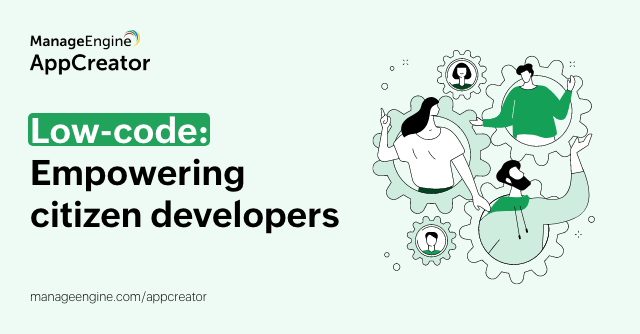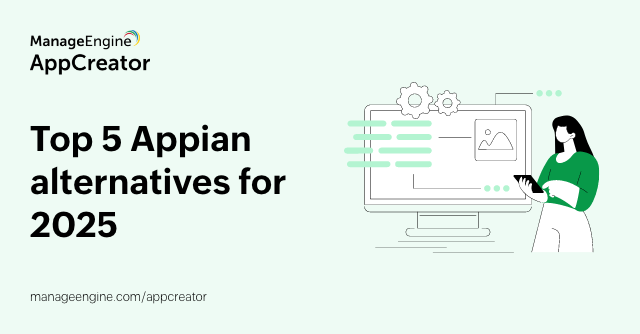- HOME
- Citizen development
- The age of the citizen developer: How low-code empowers them
The age of the citizen developer: How low-code empowers them
- Last Updated: June 3, 2025
- 426 Views
- 8 Min Read

Traditionally, computer programming has been under the dominion of professional programmers—engineers who code. It is an inherently complex endeavor because of its highly technical nature. This nature mandates that those who are proficient in programming attend school specifically for it or be self-taught. Both of these methods require lots of dedication and necessitate a massive investment of time. Also, people who are proficient in programming are paid a lot for their expertise. This makes traditional software development an expensive and slightly complex endeavor.
For a long time, this was the status quo. Then, different approaches to software development arose. Among the first was the waterfall model, followed by agile development models such as the rapid application development model, and then it all changed with the advent of an offshoot—low-code.
What is low-code?
Low-code is the usage of minimal programming to develop fully functional desktop and mobile applications. Low-code platforms provide drag-and-drop tools and point-and-click visual interfaces to develop applications. These platforms abstract away the complexities in software development, enabling line-of-business users and non-technical people to develop applications with no prior technical knowledge, all by themselves.
If you want to implement some custom features that are not provided by default in a low-code platform, you can do so by using dedicated, simple, easy-to-learn scripting languages that are similar to English. So, in low-code, you can also code, but it's much easier than in conventional computer programming.
The advent of low-code platforms has thrown open the world of software development to a new class of software developers: citizen developers.
Who are citizen developers?
Citizen developers are those who do not know traditional computer programming or who do not have expertise or experience scripting in full-stack software development frameworks; essentially, non-technical people with limited software engineering experience.
Citizen developers typically use tools and methodologies which require minimal prior technical knowledge, like no-code or or low-code platforms, to develop applications and software.
What is citizen development?
Citizen development is the process where application development for organizational business processes, workflow automation, and digitization lies in the hands of line-of-business developers.
Whom does citizen development empower?
It empowers line-of-business users who do not have programming or application development knowledge—citizen developers.
The need for citizen developers
There are multiple reasons for today's demand for citizen developers.
The exigency for computer programmers
This is the stimulus for the emergence of citizen developers in contemporary times. The demand for new software solutions is so high, it exceeds the number of available computer programmers. If common people are empowered to develop applications, it will address this shortage.
Computer programmers are expensive
Computer programmers are expensive to hire. Consequently, software firms which engineer software for business process automation charge a huge fee for their services. Many businesses require an economical alternative to conventional software engineering.
Reduced dependency on IT teams
It's important to enable line-of-business users to develop applications themselves. Line-of-business users are traditionally dependent on IT teams to develop solutions that automate organizational business processes. However, these users typically have more domain knowledge than the IT team. By empowering these users, their dependency on the IT teams is reduced, allowing IT teams to concentrate on more critical tasks.
Software development takes time
We also need to consider the generally slow pace of conventional software development. Traditionally, software development takes months, or in some cases, even years to bear fruition. Citizen developers powered by low-code platforms can develop applications in a fraction of the time it takes to develop the same applications the conventional way.
Having seen some of the major reasons for the demand for citizen developers, we will now take a look at the typical characteristics of this unique demographic.
The persona of citizen developers
The citizen developer's persona comprises of the following characteristics.
High domain knowledge
Citizen developers have very high domain knowledge. They know the ins and outs of their industry. For example, consider marketers, sales managers and representatives, or recruiters. Also included are subject matter experts. These groups of people have a strong command over their domains, this knowledge having been obtained thanks to years of experience in the field.
Elementary technical knowledge
Citizen developers have elementary technical knowledge. Because their work and expertise is non-technical in nature, the knowledge of how software operates under the hood is unbeknownst to citizen developers. They usually do not know computer programming and are not proficient in programming languages.
Clarity over business process requirements
Citizen developers can elucidate business process requirements with clarity. Owing to their deep understanding of their domain, they can perfectly list the ins and outs of the enterprise's everyday processes. This deep understanding of business process requirements makes for solid operational collateral, from a viability perspective.
How to become a citizen developer
To become a citizen developer, you need to have the following attributes:
i) You should have extensive domain experience and should be a subject matter expert.
ii) You should be able to orchestrate organizational processes manually, from initiation and execution to completion and sign-off. Only if you are manually familiar with a process can you automate it and subsequently develop applications addressing it using low-code or no-code platforms.
iii) You should be able to identify a low-code or no-code platform that supports citizen development and become proficient in developing applications in it.
iv) You should identify the processes that can be automated using low-code after thorough analysis.
Identifying the right low-code platforms for citizen developers
There are several low-code app development platforms out there, ranging from those which require no coding whatsoever to those which require extensive low-code scripting. The latter category of low-code platforms are counterintuitive because the principle of low-code is to minimize scripting as much as possible.
In the case of citizen developers, the best low-code platforms are those that simplify the application development process.
Tips for identifying the best citizen-developer-friendly low-code platform
A typical citizen-developer-friendly low-code platform should have the following features.
Small learning curve
The platform should have a very small learning curve. Its interface, features, and capabilities should be easy to understand. It should be simple and straightforward to use.
Drag-and-drop application builder
The low-code or no-code platform should provide a drag-and-drop application builder, where you can build applications through component-based development. The components, for example, can be forms used to collect information from end users or menus and dashboards that collate information and display it in a visually rich manner.
In an optimal low-code platform architected for citizen development, there should be no coding required to develop the user interface or the primary components of the applications. This will ensure that the citizen development process proceeds without being delayed by software programming for interface development.
Prebuilt templates
Why reinvent the wheel? Based on this principle, several low-code development platforms and all no-code development platforms offer prebuilt templates. These templates provide a skeletal framework on which applications can be instantly built and expanded upon.
Point-and-click workflow building
You can think of a workflow as being similar to a flowchart. It is the sequence of events in a business process, from initiation to completion. In organizations, workflows are everywhere. With technology, you can engineer a workflow to achieve a particular outcome.
An ideal workflow builder should provide a point-and-click interface to develop workflows without any coding. It should therefore enable stakeholders to easily automate complex business processes by converting them to seamless workflows that involve all pertinent stakeholders.
Also, it's best if there are prebuilt templates for commonly used workflows in organizations.
Easy multi-platform development and deployment
Contemporary applications are accessed by users on multiple platforms, such as the web and on mobile devices. Some low-code and no-code application development platforms today offer the ability to develop applications simultaneously for these platforms. It's optimal to choose a low-code or no-code development platform that supports easy deployment to multiple platforms.
Steps in using low-code platforms for citizen developers
Choose the low-code platform that will be leveraged
The first step is for the citizen developer to choose from the plethora of choices available in the industry, from simplistic no-code development platforms to complex low-code platforms powered by integrated development environments.
Identify the processes
The next step is to identify the processes that require application development (to process and execute them) and which workflows need to be automated.
Processes abound in an organization. Every department—whether operating in silos or in collaboration with others—has its own unique set of business processes that drive organizational objectives to completion.
In this phase, the citizen developer lists critical business processes in order of decreasing priority. These are the processes that will be digitally transformed into applications and workflows.
Create applications and workflows
The citizen developers then develop applications that will serve the end objectives of the business processes identified in the previous step. Based upon the requirements of each process, they tailor the applications according to its unique demands.
In tandem with applications, citizen developers will also create workflows. Workflows are used to mechanize repetitive processes by automating them. Each workflow consists of inputs, which are subject to a process, and the workflow transforms the input into the desired output.
When you begin creating applications that when executed achieve the end goals of a business process, and when you automate business processes using workflows that can be automatically executed with minimal human supervision, then you are on the right track to effective digital transformation.
Evaluate and validate the applications built
The process doesn't conclude with the creation of applications and the transformation of mundane business processes into workflows. As a citizen developer, it is also your responsibility to evaluate the applications and workflows you've built on the low-code platform to ensure that they conform to organizational requirements and standards.
There are two Vs to consider: verification and validation. Verification is checking if you are building the product right, and validation is ensuring you are building the right product. This tenet, derived from software quality assurance, ensures that you don't steer away from pragmatic business objectives.
Deploy the applications and workflows
The final stage entails the deployment of applications and organizational workflows. The end users—who comprise critical stakeholders—begin interacting with the applications and workflows you've created. This sets digital transformation in motion.
Process execution is accelerated, digitized, and streamlined, and throughput, efficiency, sustainability, and profitability are increased.
An optimal low-code platform
If you are looking for a low-code platform that allows you to streamline your business processes, drive innovation, and create applications that scale your organization vertically, you can consider evaluating the ManageEngine AppCreator platform.
AppCreator offers you the right toolset to automate repetitive processes and create applications much faster than traditional methods, and with minimal coding. You can use the drag-and-drop builders to:
(i) Quickly build forms to capture essential information from your end users.
(ii) Rapidly develop visually rich, appealing yet insightful dashboards.
(iii) Pull data from multiple sources for quick yet insightful analysis.
(iv) Enforce granular user control to regulate data access and manage the hierarchy in your organization.
v) Build a single application on the web and deploy it instantly to the web, iOS, and Android platforms in a single click.
vi) Create workflows that automate mundane processes and accelerate organizational productivity.
Evaluate the AppCreator platform to see how it can empower your organization's citizen developers to facilitate and affect organizational efficiency, viability, and sustainability.



